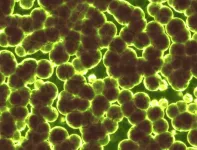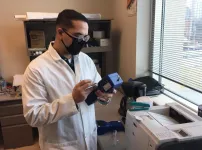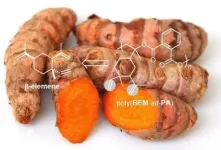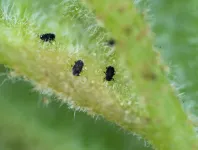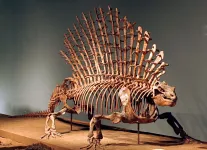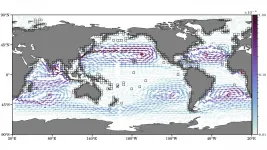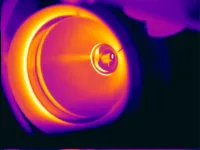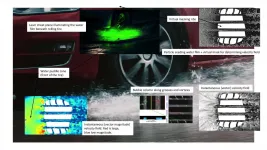New cell line could lead to more reliable vaccine development to fight costly pig virus
2021-03-02
(Press-News.org) AMES, Iowa - Vaccines are an important tool in fighting porcine reproductive and respiratory syndrome (PRRS), but the fast-mutating virus that causes the disease sometimes requires the production of autogenous vaccines tailored to particular variants.
The production of autogenous vaccines depends on the ability of scientists to isolate the virus, but sometimes that's a tricky process. A new study from an Iowa State University researcher shows that a new cell line may offer a better alternative to the cell line most commonly used to isolate the PRRS virus. That could lead to more reliable processes for creating autogenous vaccines, but most autogenous vaccine producers would have to make dramatic changes to their processes in order to adopt the new cell line, said Jianqiang Zhang, associate professor of veterinary diagnostic and production animal medicine and lead author of the study.
The article was published this month in the peer-reviewed Journal of Clinical Microbiology.
PRRS is an infectious disease in pigs that costs pork producers hundreds of millions of dollars every year to contain. Currently available commercial PRRS vaccines don't always provide effective protection to pigs due to high genetic and antigenic diversity among PRRS strains, Zhang said. So swine veterinarians often request diagnostic laboratories to isolate the virus from clinical samples to produce farm-specific autogenous vaccines.
Scientists have to grow the virus in a cell culture to isolate it successfully, and the most commonly used cell line for PRRS isolation is referred to as MARC-145, a cell line that originates in the kidneys of monkeys.
In the new study, Zhang analyzed a different cell line, referred to as ZMAC. The ZMAC cell line, derived from alveolar macrophages in pigs' lungs, was developed by Dr. Federico Zuckerman at the University of Illinois and is a patented cell line. The Iowa State University Veterinary Diagnostic Laboratory obtained the ZMAC cell line from Aptimmune Biologics, Inc., a swine disease vaccine company that licensed the ZMAC cell line from University of Illinois. The study looked at the ability of the ZMAC line to culture the virus and then compared the results to the MARC-145 line. The study demonstrated that the ZMAC cell line can significantly improve the success rate for isolating the PRRS virus.
Using the ZMAC cell line resulted in successful isolation of viruses 57.6% of the time, while the MARC-145 cell line was successful 26.3% of the time, according to the findings.
"That's potentially good for producers and veterinarians to produce farm-specific vaccines, but there's a challenge because not all companies have adopted this ZMAC cell line," Zhang said.
If scientists can't isolate a particular virus variant, then they can't produce autogenous vaccines to target that variant. So a cell line that successfully isolates the virus more often could be a valuable tool in producing more tailor-made vaccines.
"However, it is noteworthy that, when PRRS virus isolates obtained in ZMAC cell line were adapted to grow in MARC-145 cell line, only 57.3% of them grew and 42.7% did not grow", Zhang said. "Considering that the vast majority of autogenous vaccine companies still rely on the MARC-145 cell line in their vaccine production systems, it may happen that some of them cannot produce autogenous vaccines even if a PRRS virus isolate is obtained in ZMAC cell line. It remains to be seen how readily they'll adopt the use of the new ZMAC cell line."
In the meantime, the research team notes that further study of these cell lines could fill in gaps in their understanding of why the ZMAC cells isolated the virus at a higher rate.
"Overall, a better PRRS virus isolation outcome can be achieved in ZMAC cells than in MARC-145 cells," the study says. "The details of the mechanisms remain to be elucidated. It is suspected that the mechanisms are related to virus genetic diversity and the interaction between viral proteins and host cell receptors."
INFORMATION:
[Attachments] See images for this press release:

ELSE PRESS RELEASES FROM THIS DATE:
2021-03-02
For nearly a century, improvement in human healthcare has depended heavily on the efficiency with which we can treat bacterial diseases. But today, antibiotic resistance--the ability of certain mutant super-bacteria to block out antibiotics--poses a major threat to healthcare, food security, and overall social development worldwide, threatening to upend much of the progress our civilization has achieved.
Scientists are now urgently attempting to tackle this problem from various angles. Professor Yunho Lee at Gwangju Institute of Science and Technology (GIST), Korea, whose contribution is published in the American Chemical Society's Environmental Science and Technology, is looking at it from the point of view of his field of research--wastewater ...
2021-03-02
If you're looking for an indoor space with a low level of particulate air pollution, a commercial airliner flying at cruising altitude may be your best option. A newly reported study of air quality in indoor spaces such as stores, restaurants, offices, public transportation -- and commercial jets -- shows aircraft cabins with the lowest levels of tiny aerosol particles.
Conducted in July 2020, the study included monitoring both the number of particles and their total mass across a broad range of indoor locations, including 19 commercial flights in which measurements took place throughout ...
2021-03-02
Finding innovative and sustainable solutions to our material needs is one of the core objectives of green chemistry. The myriad plastics that envelop our daily life - from mattresses to food and cars - are mostly made from oil-based monomers which are the building blocks of polymers. Therefore, finding bio-based monomers for polymer synthesis is attractive to achieve more sustainable solutions in materials development.
In a paper published in ACS Sustainable Chemistry & Engineering, researchers from the Kleij group present a new route to prepare biobased polyesters with tuneable properties. The researchers ...
2021-03-02
Insects can reprogram plant growth, transforming ordinary plant parts into intricately patterned shelters that are safe havens for feeding and reproduction.
These structures, called galls, have fascinated biologists for centuries. They're crafted by a variety of insects, including some species of aphids, mites, and wasps. And they take on innumerable forms, each specific in shape and size to the insect species that's created it - from knobs to cone-shaped protrusions to long, thin spikes. Some even resemble flowers.
Insects create galls by manipulating the development of plants, but figuring out exactly how they perform this feat "feels like ...
2021-03-02
The backbone is the Swiss Army Knife of mammal locomotion. It can function in all sorts of ways that allows living mammals to have remarkable diversity in their movements. They can run, swim, climb and fly all due, in part, to the extensive reorganization of their vertebral column, which occurred over roughly 320 million years of evolution.
Open any anatomy textbook and you'll find the long-standing hypothesis that the evolution of the mammal backbone, which is uniquely capable of sagittal (up and down) movements, evolved from a backbone that functioned ...
2021-03-02
WASHINGTON, March 2, 2021 -- Tons of plastic debris get released into the ocean every day, and most of it accumulates within the middle of garbage patches, which tend to float on the oceans' surface in the center of each of their regions. The most infamous one, known as the Great Pacific Garbage Patch, is in the North Pacific Ocean.
Researchers in the U.S. and Germany decided to explore which pathways transport debris from the coasts to the middle of the oceans, as well as the relative strengths of different subtropical gyres in the oceans and how they influence long-term accumulation of debris.
In Chaos, from AIP Publishing, Philippe Miron, Francisco Beron-Vera, Luzie Helfmann, and Peter Koltai report creating a Markov chain ...
2021-03-02
What The Study Did: This study investigates emergency department visits for violence-related injuries occurring at home and outside the home in Cardiff, Wales, before and after COVID-19 lockdown measures were instituted in March 2020.
Authors: Jonathan P. Shepherd, Ph.D., Crime and Security Research Institute at Cardiff University in Wales, is the corresponding author.
To access the embargoed study: Visit our For The Media website at this link https://media.jamanetwork.com/
(doi:10.1001/jama.2020.25511)
Editor's Note: Please see the article for additional information, including other authors, author contributions ...
2021-03-02
In a mouse study, Australian researchers have mapped out what happens behind the scenes in fat tissue during intermittent fasting, showing that it triggers a cascade of dramatic changes, depending on the type of fat deposits and where they are located around the body.
Using state-of-the-art instruments, University of Sydney researchers discovered that fat around the stomach, which can accumulate into a 'protruding tummy' in humans, was found to go into 'preservation mode', adapting over time and becoming more resistant to weight loss.
The findings are published today in Cell Reports.
A research team led by Dr Mark Larance examined fat tissue types from different locations to understand their role during every-other-day fasting, ...
2021-03-02
The first UK COVID-19 lockdown saw a "rapid and sustained" fall in violence outside the home in the Welsh capital city, a new study led by Cardiff University has shown.
Researchers from Cardiff University's Crime and Security Research Institute (CSRI) and the US Centers for Disease Control and Prevention studied data from Cardiff's sole emergency department (ED) from March to June 2020 and compared it to weekly data from January 2019 onwards.
They found there were almost 60% fewer attendances per week for violent injury outside the home in the first lockdown during ...
2021-03-02
WASHINGTON, March 2, 2021 -- When a vehicle travels over a wet or flooded road, water builds up in front of the tire and generates a lift force. In a phenomenon known as hydroplaning, this force can become large enough to lift the vehicle off the ground.
In Physics of Fluids, by AIP Publishing, scientists from the CNRS, the University of Lyon, and The Michelin Group use a laser imaging technique to study water flow in front of and through tire grooves.
To counteract hydroplaning, tread designs are chosen to drain water from the front of the tire without decreasing its ability to adhere to the road. Very few quantitative experimental studies of the movement of water through tire grooves have been done, so little is known about the exact flow patterns in ...
LAST 30 PRESS RELEASES:
[Press-News.org] New cell line could lead to more reliable vaccine development to fight costly pig virus

